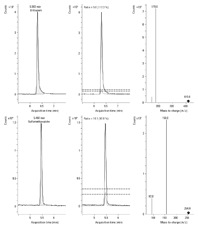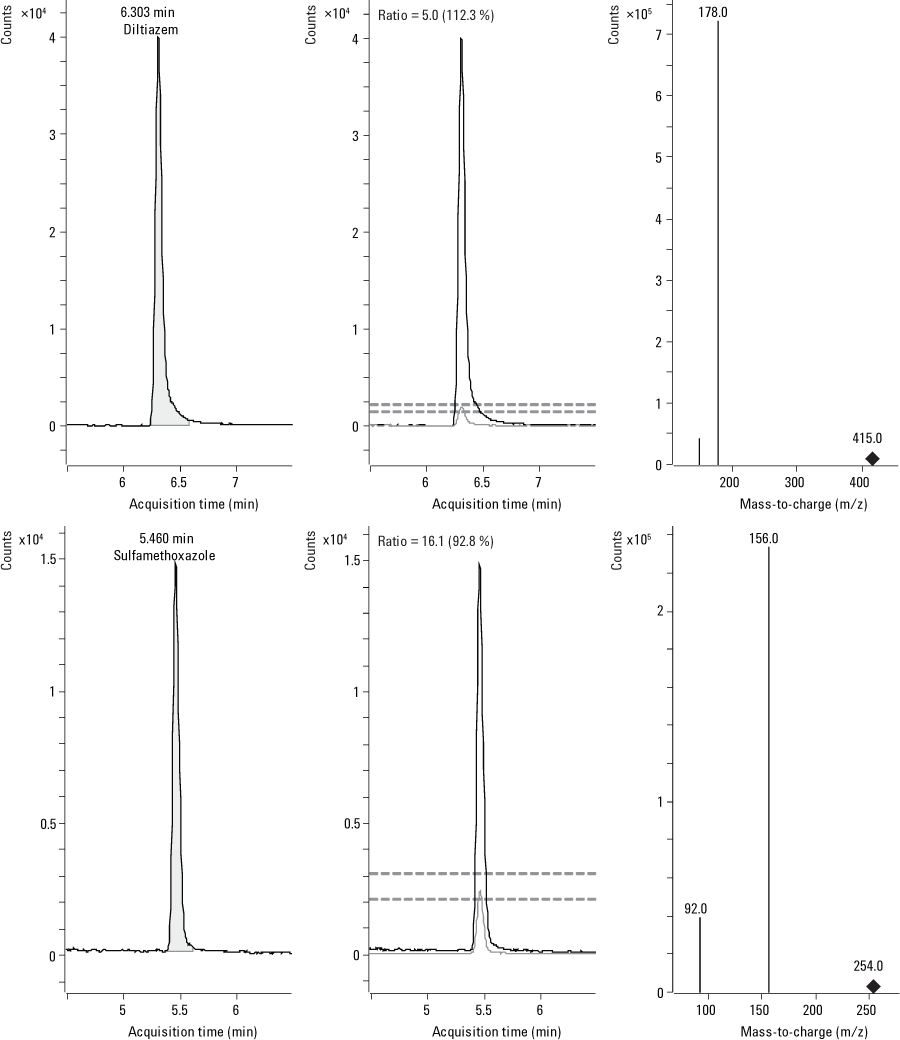Access Agilent eNewsletter, August 2013
>> Update My Profile | Subscribe to Access Agilent | Article Directory

Sensitive, lower cost analyses of emerging contaminants in water by LC/MS/MS
By Joe Weitzel
Agilent Global Environmental Manager
Tarun Anumol, et al.
University of Arizona
Imma Ferrer and E. Michael Thurman
University of Colorado
Scientists are discovering chemicals in water that previously had not been detected or are being detected at levels that are significantly different than expected. These chemicals are generally called contaminants of emerging concern (CECs), because we may not know the risk to human health and the environment associated with their presence, frequency of occurrence, or source. This article describes two recent LC/MS/MS analyses for CECs. One is a rapid and sensitive method used to monitor trace-level CECs across a wastewater treatment process. The other is the ng/L analysis of pharmaceutical and personal care products (PPCPs) in surface water without time-consuming sample pre-concentration.
The United States Environmental Protection Agency (EPA) is working to improve its understanding of a number of CECs, such as PPCPs and perfluorinated compounds. Because CECs are found with increasing frequency in the world’s streams, lakes, and ground water, this improved understanding is necessary to measure the potential threat to the environment and human health.
Some CECs are known endocrine disruptors, while others affect glucocorticoid activity. The synergistic effects of long-term exposure to low doses of CECs are yet unknown. As a result, the EPA has instituted Unregulated Contaminant Monitoring Rules (UCMRs) to assess the potential threat of CECs in the water supply.
In addition to investigating these known potential threats to water quality, it is important to bridge the gap between detection and health by development of methodologies that can screen water for toxicity from multiple compounds. Addressing contaminants in potable water as mixtures (as opposed to separate chemicals) is of great interest to regulatory, scientific, and public communities. We give two examples here.
High sensitivity UHPLC for analyses at low ppt levels
Scientists at the University of Arizona developed a UHPLC/MS/MS method on an Agilent 1290 Infinity LC coupled to an Agilent 6460 Triple Quadrupole LC/MS System, using positive and negative electrospray ionization. It provided limits of detection (LODs) and limits of quantitation (LOQs) for most of the 36 compounds that were at or even well below 1 ppb, and method reporting limits (MRLs) that ranged from 0.1 to 15 ppt.
These researchers used an Agilent ZORBAX Eclipse Plus C18 column for the separation, which required less than 20 minutes per sample. At treatment plants in Arizona and California, they applied this method to monitor CEC levels across the wastewater treatment process, from crude wastewater to dechlorinated final effluent. Table 1 shows that the levels of some CECs exceeded 1,000 ng/L, even after water treatment. It is also evident that the treatment plants differed markedly in their ability to remove some CECs, for example sulfamethoxazole and benzophenone. [1]
Wastewater treatment plant 1 |
Wastewater treatment plant 2 |
||||||
|---|---|---|---|---|---|---|---|
Compound |
After bar screens |
After BNROD1 |
After sand filter |
After chlorination |
After clarifier |
Secondary effluent after activated sludge |
Dechlorinated final effluent |
ESI positive analysis |
|||||||
Sucralose |
8,979 |
8,171 |
7,573 |
7,954 |
>6,000 |
>6,000 |
>6,000 |
Sulfamethoxazole |
6,078 |
3,909 |
3,013 |
39 |
2,287 |
843 |
1,134 |
Tris(1-chloro-2-propyl) phosphate (TCPP) |
5,665 |
3,874 |
3,408 |
2,907 |
1,654 |
2,903 |
3,035 |
Benzophenone |
4,541 |
314 |
318 |
219 |
>4,000 |
2,318 |
1,708 |
ESI negative analysis |
|||||||
Ibuprofen |
>8,000 |
50 |
<MRL2 |
<MRL |
>6,000 |
1,810 |
1,589 |
Gemfibrozil |
>6,000 |
399 |
234 |
193 |
2,747 |
2,382 |
2,188 |
1Biological nutrient removal oxidation ditch
2Method reporting limit
Table 1. Measurement of selected contaminants of emerging concern (ng/L) in wastewater across treatment stages at treatment plants in Arizona and California.
 Enlarge
Enlarge
Figure 1. Ion chromatograms (left) show positive findings for diltiazem and sulfamethoxazole in surface water. Middle shows ion ratios, while right shows corresponding spectra.
Reduce costs by eliminating pre-concentration
Direct analysis of pharmaceutical and personal care products in surface water collected near Denver, Colorado used an Agilent 6490 Triple Quadrupole LC/MS System with Agilent Jet Stream and Dual Ion Funnel Technology. As above, scientists used an Agilent ZORBAX Eclipse Plus C18 column to construct calibration curves. They required no sample pre-concentration to measure a suite of 20 PPCPs at limits of detection that varied from 1 to 500 ng/L, depending on the chemical structure and ionization efficiency of the analyte. The elimination of sample pre-concentration steps dramatically reduced sample preparation time, increased ease of analysis, and reduced cost, while offsetting potential matrix effects in some solid phase extraction (SPE) methods.
Figure 1 shows the qualifying ion abundance ratios for two of these compounds, diltiazem and sulfamethoxazole. Both pharmaceuticals were readily identified in a complex matrix of PCPPs, due to the selectivity of the multiple reaction monitoring (MRM) transitions and instrument sensitivity. [2]
Agilent solutions for sensitive, high-throughput water analyses
These are just two examples of Agilent’s water analysis solutions, which enable precise, high-throughput analyses of emerging contaminants in water at very low concentrations. These powerful techniques can now separate and identify individual contaminants in complex mixtures, an important advance given the increasing use of pharmaceutical and personal care products that enter water sources worldwide as contaminants of emerging concern.
References
- Tarun Anumol, Sylvain Merel, and Shane Snyder. “High Sensitivity HPLC Analysis of Contaminants of Emerging Concern (CECs) in Water using the Agilent 6460 Triple Quadrupole LC/MS System,” Agilent Application note 5991-1412EN (2012).
- Imma Ferrer and E. Michael Thurman. “Direct Aqueous Analysis of Pharmaceuticals in Water at ppt levels by LC/MS/MS with the Agilent 6590 Triple Quadrupole LC/MS System with Ion Funnel Technology,” Agilent Application note 5990-6431EN (2010).
>> Update My Profile | Subscribe to Access Agilent | Article Directory
